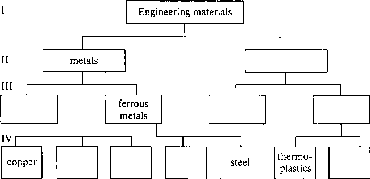В. Н. Бгашев е. Ю. Долматовская английский язык для студентов машиностроительных специальностей учебник
 Скачать 1.36 Mb. Скачать 1.36 Mb.
|
|
Пользуясь таблицей, произведите классификацию: а) учебных заведений России; б) высших учебных заведений Великобритании; в) факультетов вашего учебного заведения. TEXT STUDY а) Пользуясь информацией текста, дополните схему. Classification of Engineering Materials  б) Составьте не менее восьми предложений, пользуясь схемой. Например: Steel is a ferrous metal. 2. Iron and steel are ferrous metals. а) Начертите схемы, отражающие связь между следующими объектами. alloys, copper, brass, pure metals, aluminium, metals; milling machines, сору-miller, shaping machines, drilling machines, vertical shaper, radial arm drill, machine-tools; petrol engines, external-combustion engines, diesel engines, heat engines, steam turbines, internal-combustion engines б) Составьте не менее десяти предложений, пользуясь своими схемами. Например: Metals can be classified as pure metals and alloys. Copper and aluminium are pure metals and brass is an alloy. DISCUSSION Ответьте на вопросы. What kinds of materials are used in engineering? 2. How are metals classified? 3. What is the difference between ferrous and non-ferrous metals? 4. For what purpose are some elements (such as chromium and tungsten) added to steel? 5. What kinds of non-metals do you know? What can you say about classification and properties of plastics? 7. In what cases are ceramics used? Приготовьте сообщение на тему “Engineering Materials”. Используйте для этого схему из раздела “Text Study” и активную лексику раздела. Ситуации для развернутых высказываний. а) Вы инженер-металлург. Ваша задача — получить высококачественную легированную сталь. Скажите, как вы можете добиться этого. б) Ваша лаборатория проводит опыты в условиях высоких температур. Скажите, какими качествами должно обладать лабораторное оборудование и какие материалы можно использовать для его изготовления. Active Vocabulary
в Просмотрите текст и определите: а) в каких абзацах описывается технология получения пластмассы различных видов; б) в каком абзаце описываются свойства пластмассы; в) основные шаги деятельности изобретателя, в честь которого назван бакелит. TEXT В. THE PLASTIC AGE It’s in our homes. It’s the most common material in the workplace. Sometimes it’s even in our bodies. We may be moving into the Information Age, but it’s hard to believe that we are not living in the Plastic Age. The very name “plastic” means versatility. You can bend it, mold it, model it, twist it and ply it in a number of different ways. The finished product can be a soft and airy foam or a hard and strong compound rivaling the sturdiest metal alloys. In its many forms, plastic has forever changed the way we live. The first in the long line of man-made plastics was called Bakelite, after its inventor, Leo Baekeland. Many years of work in his chemistry lab in Yonkers, New York, led him in 1907 to the invention of the first synthetic polymer (plastic), made by linking small molecules together to make large ones. Baekeland made his new material by mixing the carbolic acid (phenol) with the strong-smelling formaldehyde to make a third material that was nothing like the original two. It turned out to be a substance that would change the world. Some of the early uses for plastic were to make things like radio cabinets, buttons, billiard balls, pipe-stems, toilet seats, airplane parts and, the object of Baekeland’s research, shellac. Baekeland’s trick was to take the resin produced by the two chemicals and heat it under pressure to produce a soft solid that could be molded and hardened or powdered and set under pressure. With this innovation, the plastic revolution was under way. carbolic acid карболовая кислота formaldehyde формальдегид shellac шеллак DISCUSSION Подготовьте сообщение на тему “The substance that changed the world” по плану: а) properties of plastics; б) the first man-made plastics; в) the early uses for plastic. свойства результат процесс исходные материалы Step 2 А Переведите заголовок текста. Бегло просмотрите текст и скажите: а) в каком абзаце обобщенно изложены требования к современным конструкционным материалам; б) в каких двух абзацах речь идет о свойствах стали; в) какой абзац текста обобщает содержание таблицы на с. 133. TEXT A. NEW STEELS MEET CHANGING NEEDS As a structural material steel has two drawbacks: its weight and its susceptibility to rust. However, due to its advantages, steel has long been used, and in great quantities, in structural applications from bridges and buildings to ships, automobiles and household appliances. Steel is superior to other structural materials in strength, toughness, workability and other properties that are critical for such applications, and it is mass-produced with uniform, reliable quality and at low cost. Since steel is the most popular structural material available, steelmakers make every effort to meet the changing needs of these markets. New, more sophisticated processes for steel-making and treatment have led to steel products of higher grade and greater variety. Yet, it can no longer be said that a steel product is satisfactory if it is simply a good structural material. Today’s market needs can be classified broadly as: 1) the need for lighter weight; 2) the need for new properties; 3) the need for maximum performance; and 4) tHe need for cost reduction. The need for lighter weight is really a requirement for materials having higher specific strength (strength/specific gravity). Materials offering new properties not found in conventional materials will include new breeds of steel, hybrid materials and truly novel materials such as amorphous metal. The need for maximum performance calls for materials approaching the limits of durability, toughness and the like. Finally, the need to reduce costs is leading to materials diversification in which steel materials precisely suited to a specific application are developed. New families of steel products are steadily emerging to meet these needs. Let us look now at how steel needs have changed in automotive industry and how steelmakers have met these needs. What is Needed in New Steels by Automotive Industry
TEXT-BASED ASSIGNMENTS LANGUAGE STUDY |
